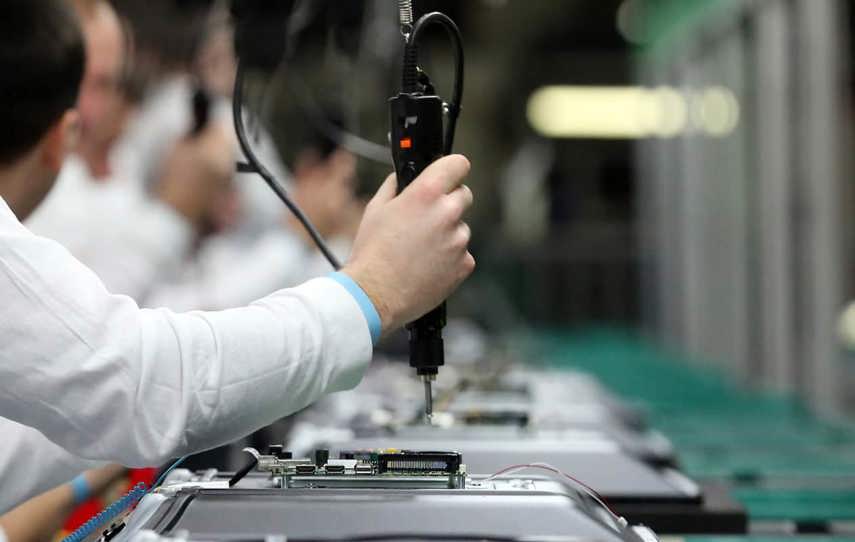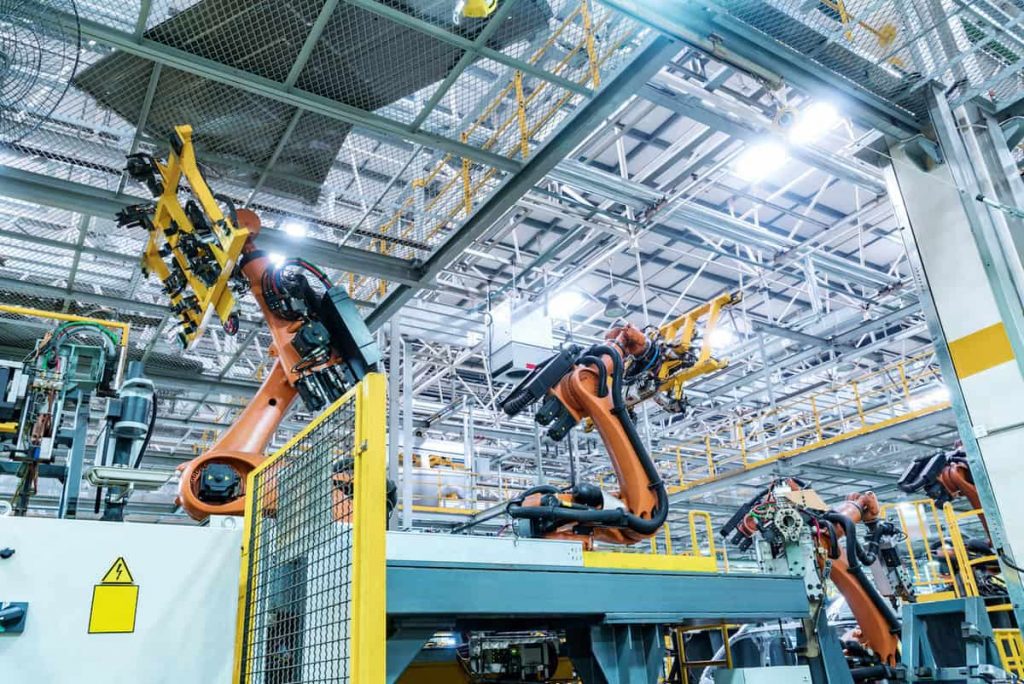
Manufacturing goods and products can be monumental task; heavy on a company’s precious time and resources, particularly as a business grows. Thankfully advances in technology have helped many manufacturers cut down on the time and effort it takes to finish a batch of products – helping them maintain a competitive edge in their industries and keep their customers happy.
The flexible manufacturing system is one of those, and here we’ll look at what it is and businesses that use it, and discuss strengths and weaknesses and how it can help your business.
- Read more: The Modern Manufacturing Guide
What is the flexible manufacturing system?
Flexible manufacturing is all about adaptability – that is, the ability to adapt to changes in product requirements without compromising on quality. A flexible manufacturing system (FMS) is the production method that helps make this happen, and it can cut down both on production times and the amount of resource required.
The system is designed to adapt to changes like slight (or more significant) variations to a product, production volumes – or even the addition of entirely new products. It does this with the help of computers and machines that can automate key manufacturing processes, including machining and assembly, loading and unloading, and data processing.
It can cut and form metal, weld and join, and assemble, test, and inspect parts. It can also deburr, shave, and apply finishing treatments to pieces, making parts presentation-ready.
Because the system is automated, it relies less on human power than traditional manufacturing methods, which has both advantages and disadvantages. We’ll look at these below.
 With the help of flexible manufacturing systems businesses can automate key manufacturing processes
With the help of flexible manufacturing systems businesses can automate key manufacturing processes
Types of flexible manufacturing system
There are five different types of FMS. These are:
Sequential FMS
This type of FMS is similar to a small batch flexible transfer line. It manufactures one type of part and then prepares to manufacture another type in a pre-determined sequence.
Random FMS
As the name suggests, this type of FMS will manufacture a random mix of parts with varied configurations at any given time using machines that are able to handle a mix of product specifications. It can also progress through parts in random order.
Dedicated FMS
A dedicated FMS is less flexible than its random counterpart. Instead of manufacturing a large variety of parts, it will only produce a limited mix but will do so continuously for long periods of time, making its production rate higher.
Engineered FMS
An engineered FMS continuously makes the same parts.
Modular FMS
The modular FMS allows the operator to switch between sequential, random, dedicated, and engineered FMS modes depending on production needs.
What is a flexible manufacturing cell?
A flexible manufacturing cell (FMC) comprises two or three machines including processing workstations and a parts handling capability. While it's less complex and sophisticated than an FMS, an FMC has flexible capabilities as well, including rerouting a product from one machine to another should one of them fail, and the ability to adapt to an increase in production volumes.
An FMS is larger than an FMC. It is made up of four or more machines and has more supporting parts, including wash stations for parts and pallets, and storage stations. It also has a more advanced computer system with a greater number of functions, such as monitoring and diagnostics.
If you’re looking for a flexible manufacturing solution for your business, you might consider both options depending on your size, resource, and space. An FMS is more flexible, but requires more space, and with its complexity, will require more training with a bigger learning curve. It also comes at a greater cost which will likely require a higher level of buy-in from senior staff and managers.
Flexible manufacturing examples – companies that use FMS
Flexible manufacturing systems are used to produce parts and products for a range of industries, particularly those relying on high-quality metal-based elements like the aerospace, medical, military, construction, and mining industries. They are also used in more consumer-facing industries like automotive and electronics.
The companies that use FMSs are often those that supply the big players in those industries, but there are also global brands like Siemens that use them. The German multinational uses FMS to produce its Simatic controllers, for example.
Car companies like Ford have also invested significantly in flexible manufacturing, helping to help increase agility when market forces demand more of one type of model over another, for example.
Lesser mainstream manufacturers like Prince Industries – which produces products for the healthcare, telecommunications, and construction industries, among others – also uses an FMS to streamline their processes and increase their hours of operations. According to the company, since it started using the FMS, its production time for products from start to finish has gone down by 50%.
Advantages of the flexible manufacturing system
The advantages of an FMS can be significant for the right company. If overall you’re producing a high volume of products with the potential for a significant number of variations in a competitive industry, FMS might be right for you. Let’s look at some of the benefits:
Flexibility
As the name suggests, flexibility is the name of the game with FMS. There are times companies will need to scale up production volumes at short notice, add entirely new products, or allow for variations in a specific line of products. The FMS is of course designed for just these scenarios, simplifying the process significantly with automated systems that can adapt to changes fluidly.
Customisation
The ability to modify products has become increasingly important, particularly as customers demand a greater say over their products and the option to tailor them to their style, taste and needs. But as most manufacturers know, customisation can be a complicated, time-consuming and expensive process. FMS comes into its own with the ability to modify and customise products easily.
Speed and efficiency
Automated systems and powerful machinery mean that the time it takes for a product to be made can be greatly reduced, thanks to quicker set-up and loading times, through to machining, tool-changing, unloading, and cleaning times.
But it’s not just about the amount you can get done in normal working hours. With an FMS, operations needn’t stop after hours, on weekends, or on holidays. This ability to work around the clock can have huge positive implications for a business looking to increase both its speed and volume of production.
Quality
Powerful and durable machinery with high-precision and testing capability can mean improved product quality and consistency, which of course helps keep customers happy with your products – and helps avoid potentially costly defaults downstream.
Improved intelligence
With the ability to collect data, monitor production, and test products, an FMS can be a valuable insight tool for your company, allowing you to understand your production capabilities and make future plans and decisions with more confidence.
Labour
Implementing an FMS will mean you need less staff working to make products as the machines will replace the need for some of this labour. This will save you money of course, but there is a flip-side to be considered, which we’ll look at below.
 You’ll need to implement flexible manufacturing systems over the long run to reap the benefits
You’ll need to implement flexible manufacturing systems over the long run to reap the benefits
Disadvantages of the flexible manufacturing system
FMS won’t be right for every business, particularly if cash flow is an issue. Some of the downsides to FMS are:
Cost
While the long-term benefits may well make it worthwhile, implementing an FMS will require significant up-front costs and associated maintenance costs which may be prohibitive for your business. Adapting equipment will likely be expensive as well. It won’t come as a surprise that financial forecasting will be crucial before committing to an FMS. It’s worth speaking to a range of providers beforehand to understand what the real value would be for your company.
Technical expertise
As we touched on above, an FMS should reduce the number of staff needed to run your production activity, but as a complex system, it will require technical expertise to operate and monitor it. You’ll also need staff for maintenance and repairs. This expertise will likely require higher salaries and could require a significant time investment in training, so it’s worth balancing out how much reduced labour will save, versus the cost of training or hiring technical operators.
Limited future changes
While it may sound counter-intuitive, as flexible as an FMS is, the system you start with won’t necessarily be the right system for some of your future needs – and you won’t always be able to retool it to reflect those needs. This is another reason why thinking about your long-term plans will be important before making a final decision.
Complex planning
A sophisticated system like this won’t just run on its own. It will require detailed plans, designs, schedules, and instructions to get going – and these will require a decent investment in your time. This may be balanced out in the end, but it’s worth considering where the time investment will be shifted in your business and making sure you have the capacity and expertise for it.
 For manufacturers like Ford, flexible manufacturing in the body shop can greatly boost efficiency
For manufacturers like Ford, flexible manufacturing in the body shop can greatly boost efficiency
Does flexible manufacturing improve productivity?
Like any tool or system, whether flexible manufacturing can increase productivity for your business will depend on the type of products you make, the volume you produce, and the amount of variation and customisation required for them.
Flexible manufacturing systems are widely claimed to positively impact productivity and quality. Studies show that investing into a long-term FMS results in reduced labour costs, increased output, decreased manufacturing costs, increased flexibility, and reduced production lead time.
FMS components: what you need for flexible manufacturing
If you decide to go with an FMS, you’ll need to get familiar with its core components. These are:
- Workstations
- Material handling and storage systems
- Computer systems
- Managers and operators
Workstations
These will generally consist of Computer Numerical Controlled (CNC) tools for machining operations, assembly, tool changing & tool storage, sensors, robots, inspection stations, loading & unloading stations, and wash stations to keep areas and surfaces clean. These are at the heart of your system and they're where production happens.
Material handling and storage systems
These are the systems that will move parts to and from where they need to go, including from storage to loading stations (primary handling systems) to machining tools for processing (secondary handling systems). This is done through the use of robots, automatic pallet changers, and other transfer devices. Automated storage and retrieval systems (AS/RS) are sometimes used as well to further automate functions and make storage processing easier.
Computer systems
Every FMS includes computers to control and collect data from various stations throughout the system. These also act an instruction system to let operators know what to do at a certain stage in a production run. This system will often consist of a central computer as well as supporting computers for various stations. The computer system will help with processes like traffic and production control, and tool and work-piece monitoring.
Managers and operators
This is of course the human element of an FMS. These will be the technically skilled staff operating, managing, and maintaining the system. As above, they will need the technical expertise to do this, and will need to work closely with staff in key business areas to ensure design specifications and deadlines are entered correctly and are met.
More posts like this:
